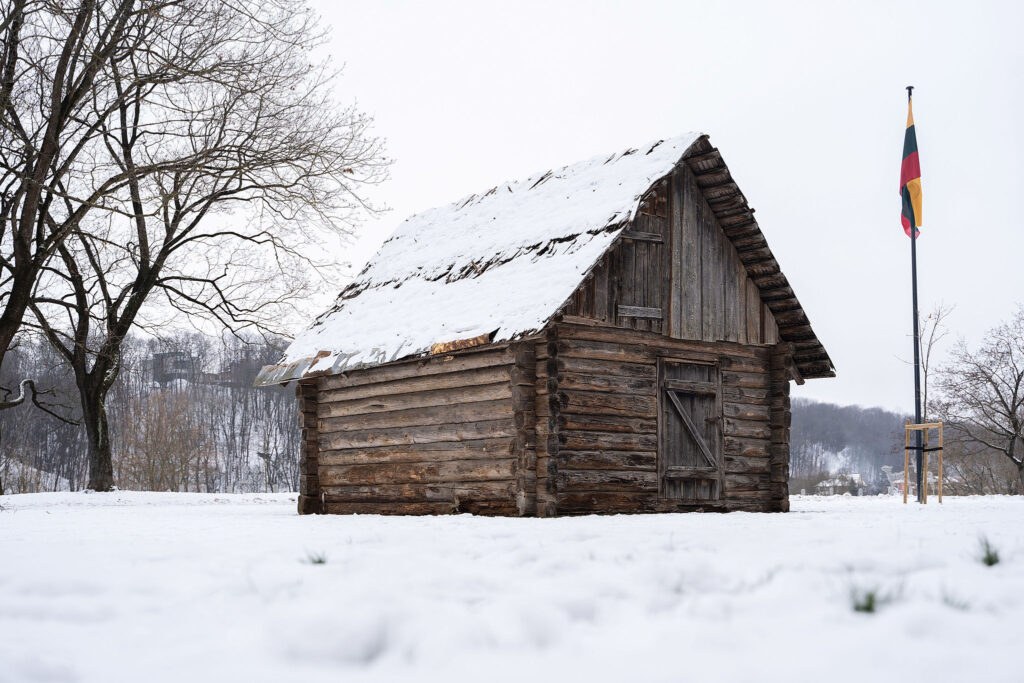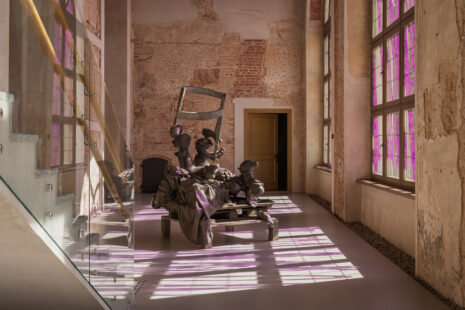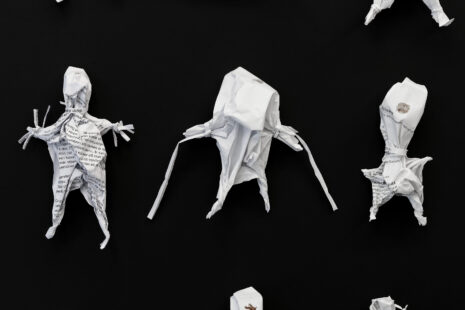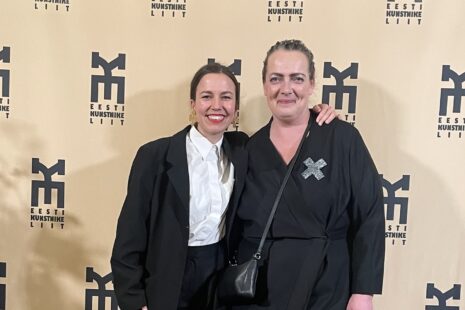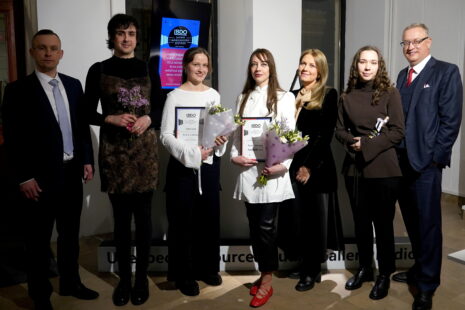From November 12th of 2021 until late February of 2022 Biennial guests will be able to dive into the elaborative world of “Once Upon Another Time…gyveno jie jau kitaip“ which roughly translates to “Once Upon Another Time…They Lived Already Differently”. This years’ curator is a contemporary art lover Canadian based curator Josée Drouin-Brisebois. Introducing the 13th contemporary art festival J. Drouin-Brisebois emphasizes that the general theme for exhibitions and artworks is humanity. How living beings operate in a face of danger, how well we, as intellectual entities, cope with terrifying oppression and how do we adapt to an ever-changing world.
Even this Biennale name subtly indicates these ideas. The title reflects the juxtaposition of old and new and how ideas change. Once upon a time, traditionally is the start of an old tale. In tales, there are some ground rules, old traditional ways of living. Word another suggests that in this particular narrative the story is different – the tale is being told about diverse, unidentifiable times, but yet different from the past. These stories and narratives are expressed through the human touch – art offers viewers to see and feel different parallels of the world. How organisms live their daily lives and ponder how new generations will live.
Artworks will invoke empathy and hopefully will encourage visitors to be more humane to one another.
One with the Architecture
13th Kaunas Biennial expositions are located in four primary exhibition spaces across the city center and a few accompanying ones showcasing art in remarkable architecture buildings. Main expositions are placed in unusual places. New contemporary buildings such as “House of Basketball” and VMU Art Gallery “101” while remaining two merges with interwar functionalism/modernism building – “Devil’s Museum” and interwar modernism “Tadas Ivanauskas Zoological Museum”. Besides, for the first time Kaunas or should I say Lithuania is coordinating entity for Creative Europe Platform called “MagiC Carpets” with the exhibition “MagiC Carpets Landed” in 1980s late modernism “Kaunas Picture Gallery”.
These places are not random, but carefully selected spaces where artworks can speak even louder than in, for example, traditional white cube galleries. The most intriguing locations not only for Kaunas visitors but locals are interwar modernism buildings. For first-time visitors in Kaunas, these architectural structures will be able to tell the history of progressive cities’ past. Residents will also be intrigued or, at least mildly irritated because all of the permanent expositions are being disrupted by intruders – artworks. A journey through museums and exploration is guaranteed for both – new and frequent visitors.
This cooperation between architecture and art is very important to the curator. According to J. Drouin-Brisebois, engaging encounters with contemporary art in unusual places such as the Zoological Museum or “101” Gallery that’s right in the “Faculty of Arts” will tell a story about the history of Kaunas itself.
For those who want to see all of the venues, they need to walk all across Kaunas – from its center to the old town where the two rivers Neris and Nemunas meet.

Christian Boltanski (France). Les regards (Glances), 1988-2001. Posters in public spaces
Objective Institutional Truth
It’s a bit symbolic that Biennale is questioning how we adapt to something inconvenient and ever-changing. Lucky for us “Tadas Ivanauskas Zoological Museum” can be a clear example of that. It’s not a secret that currently museum that’s been around for more than a decade and needed a touch-up is being renovated. Regardless of going under construction, this museum was still able to host a reasonable amount of artworks that seamlessly merged into the exposition.
Because of the renovation works visitors are met at the backup exit that’s in a different street from the main entrance. This counteraction – entering through an exit and then climbing service stairs works two ways. First, it confuses visitors. I, myself felt like an intruder silently climbing up the stairs and for the first time seeing a forbidden path – one that’s only been seen with an eye of the staff. Second, while in this state of unpleasantness and impostures feelings, suddenly, I’m being introduced to a different world – still, stiff, silent, sterile. At first, this sudden environment change from the dim-lit stairwell to the bright light chamber-room reduces alertness but after a few seconds, I started to get the feeling that’s something’s off. I looked around and noticed that in front of me stiff worlds order had been changed and the museum became more dynamic than ever. Here I’m talking about the duo from Lithuania – Pakui Hardware installations “Skewed Taxonomy”, 2021.
For me, these artworks were a big surprise. Before going to Zoological Museum, I didn’t look at the participating artists. While Pakui Hardware mostly shows their work at international galleries across the world, so to see them in person, in Kaunas was a pleasant surprise. This contemporary artists’ couple, consisting of art critic, curator, artist Neringa Černiauskaitė and photographer Ugnius Gelguda together creates an unexpected tandem. Using man-made and nature-made materials such as glass, stainless steel, resin, textiles, and wasp nests (don’t worry, they’re empty), sand, chia seeds, soil, and more make futuristic objects inspired by this museum collection.
How did these installations work in this particular space? Well, this tandem forces visitors to question everything they see in the museum insects section. Institution whose purpose is to show objective truth, in this case, different species and their evolution suddenly shows a different truth that’s fiction. What’s even more interesting is that parts of Pakui Hardware objects like the wasp nest can be seen as a constant exposition near the imposter exhibit.
These man-made sculptures question where the border between reality and fiction is and can we as spectators still separate them?
Glossy silicone, even shinier glass, and different materials in the right space suddenly become truth. Maybe not the truth but a truth.
That’s especially accurate with the first installation near the globe where there’s some sort of ancient burial from sand with glass horns. Looking at this installation and then to the globe, it feels like this exhibit tells us a story about the ancient world and its traditions. A few objects under the glass exposition put directly on a true exhibit suggest that even for a little these hybrid forms of unseen creatures are superior and truer than the ones we are used to seeing. Perhaps, such forms and their content one day will be a part of your zoological history.
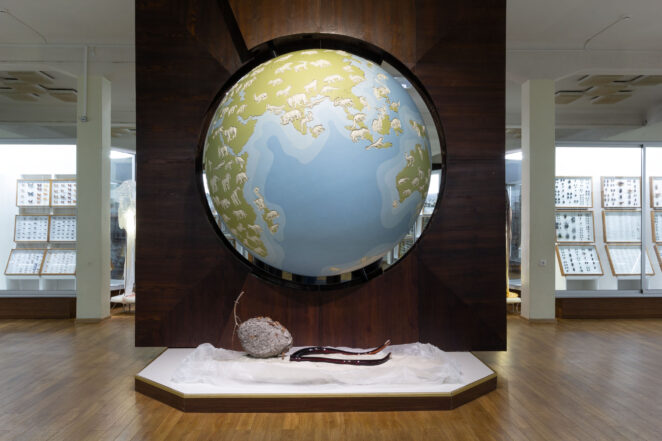
Pakui Hardware (Lithuania). Skewed Taxonomy, 2021. Glass, wasp nests, stainless steel, resin, textiles, LED lamps, latex rubber, paraffin wax, sand, chia seeds, soil and silicone
Till Death Do Us Part… Or Will It?
Another artist whose works are being shown in this museum is Lithuanian Simona Žemaitytė. “The Art of Dying”, 2021 is both – an installation and audio/video components scattered through museum floors. Visitors can see a 19 min. long abstract video about the natural elements of earth and water. These philosophical short clips are located in two selected spaces accompanying museum exhibits. One concentrates on the water part, for example, shows an organic long form that interacts with water and moves accordingly. Another screen focuses on nature – we can see a close-up hand that’s touching a ruff mountain-like surface. This research project works poetically for this space. As you wander through floors and corridors seeing precise works of taxidermy you can listen to sound recordings of interviews with different researchers focused on subjects such as soul midwives, or the theory that dreaming is a state close to being dead.
And what is death? Scientist Bernardo Kastrup in his interview states that death equals the end of disassociation.
It’s a sort of great remembrance of what was going on before you were born. What you thought and felt and knew by an acquaintance not conceptually before you were born. Walking amongst stuffed animals that have no life you truly start to wonder is death real, in what sense do our bodies contain life itself? Maybe, a part of these dead animals is still alive because of their well-preserved bodies and maybe, someday we’ll be able to successfully freeze and preserve our bodies as well.
Shadowplay
In a room with a window in the corner, I found truth…
Well, I found an interesting collaboration between contemporary space along with art and, of course, more than a single window. “House of Basketball” is the first museum in Kaunas built after the restoration of independence. Contemporary space near the lovely junction of two rivers works perfectly as a venue for Biennale expositions. This two-level building with a lot of big windows accommodating for transparency hosts one of the largest concentrations of artists and artworks. We have a mix of Lithuanian-based artists and international ones. Even though I don’t think that artworks were created in regards to this particular space the final exposition works. Some artworks need less light so we can see them on the first floor. Some look better near a window – so there they are amongst panels of glass. I’m not saying that in a negative way. My point is, that with a contemporary building like this, every space can be used. There are many recent-ish examples of how today’s museums are challenging white wall galleries with grey walls. Maybe it’s a fight between two institutions a museum and a gallery, but for me, the warm grey works.
I’ve mentioned that in this construction there are a fair amount of windows. This is exceptional for artworks on the second floor where we can see some sort of a reference for the Biennial start. I’m specifically talking about Giedrė Kriaučionytė (Lithuania), Laura Lima (Brasil), and Rasma Noreikytė (Lithuania) pieces. All artists turn around to Biennials roots – textile medium.
Walking amongst weaved linen, wool, cotton threads, and yarns what surprised me the most were two things. One of them is the cohesiveness of individual works and the wholeness of the exhibition space in general. This can be explained not only with similar materials, color choices but collaboration between Laura Lima and Lithuanian artists. Giedrė Kriaučionytė and Rasma Noreikytė were invited by Laura Lima to reflect on the following question:
“If you were to walk in the forest to observe birds and had to obscure yourselves, what would be the ‘weaving’ of choice to construct your camouflage?”
This intriguing inquiry materialized with three delicate artworks named “Fog Nets”, 2021 made by G. Kriaučionytė, and one reclaimed wool creation “Altogether”, 2021 made by R. Noreikytė. Comparing the two it’s clear that thinking about concealing themselves in nature both paradoxically chooses to stick with transparency. Tryptic and one-piece objects use a light weave which allows seeing every thread that’s being needed to create these pieces.
This airiness connects artists to L. Lima who made an installation called “Ablatanalba”, 2021. Her work is more multi-layered and a bit chaotic comparing it to the other two. In the sense of color that’s being used in all three works, G. Kriaučionytė uses three different pastel hues that can be seen more on the ocean floor rather than in the woods. Although, you need to take a good look to see these differences between the three shades. That can be done by looking at the bottom part of this installation where pieces are denser due to touching the ground. R. Noreikytė on the other hand uses natural shades of brown, ocher, amber, and green. These colors are making a subtle pattern. In L. Lima’s intertwined installation viewers can see variants used in both of the Lithuanian artists’ works. This piece is interesting because of the way it’s died. L. Lima uses natural dies found in various foods.
I’ve specified that two things surprised me seeing this exhibition. One was cohesiveness between the artworks, another is light and shadowplay between these pieces. Visiting this exhibition on a sunny day allows guests to see the amazing shadow cast made by the different lights coming from huge window panels. This light and shadow contrast is even more prominent due to direct spotlights hitting installations. “Fog Nets” look more vibrant and fairytale-like than ever. This almost radiant glow creates a mystical atmosphere and transforms linen into silk. “Altogether” mixed with light also looks a bit lighter while the audience can see the structure of different reclaimed materials used in this piece. The shadow cast on a wall echoes installation form making it appear two and three-dimensional at the same time. “Ablatanalba” affected by the light casts’ mysterious shadows similar to spider web designs. Looking at the shadows I began wondering about Plato’s “Allegory of the Cave”. Which is more real – the intertwined installation or remarkable but yet simpler shadow cast on a wall.

Giedrė Kriaučionytė (Lithuania). Fog Nets, 2021. Linen thread / Laura Lima (Brasil). Ablatanalba, 2021. Cotton threads / Rasma Noreikytė (Lithuania). Altogether, 2021. Wool, synthetic and cotton yarns
What’s Left of Us?
If these installations are less intriguing to the readers’ mind something more immersive that I can’t recommend enough is to see this year’s favorite of mine – Janet Cardiff’s and George Bures Miller’s (Canada) “Opera for a Small Room”, 2005. 20 min. surreal loop will take participants into a fictional, imaginative world of an unknown character.
After looking at textile installations visitors can go into a dark room with three chairs. This stage-setting with a musical composition and everyday objects is charming because there is no starting point when you can see it. Going to at first, dim light along with weird exhibit – wooden shipping container doesn’t appeal especially if it’s too dark (the loop is starting or ending). I saw a few people going inside and taking their smartphones to light this remote space in hopes to search for this opera. To their surprise, you need to pay a lot of attention to exclude yourself from the outside world.
Few of the visitors left this opera as soon as they arrived and felt out of place but for those who stayed, I have no doubt, opera stuck in their minds for a long time.
Why this multimedia sound work is so immersive and intriguing? Well, the main idea behind this installation is simple – participants look at this wooden container through small openings – windows where they can see various objects. Even though people can’t go inside this box and touch its content it still feels like we see a room without any wooden walls in front. Shelves with a massive vinyl collection, chandelier, two speakers, curtains, and much more.
Sitting and looking at these objects, all of a sudden we hear a sound or rather a narrative told by an unknown bodiless man. Suddenly all objects start to work together – light twinkles accordingly to the intense narrative, record player changes vinyl from one to another. At times small lights are twinkling above spectators’ heads. The storyteller sometimes is being interrupted by classical music and occasionally by ambient, sounds of rain and thunder along with trail noises, blue light. We quietly listen to the surrounding sounds, impatiently look at what’s going to happen next. The spectator at this point becomes some sort of voyeurist invading someone else’s space. Lights and musical composition plays a big role in this performance, as important as the storyteller himself. Through the small gap between his room wood panels, we manage to unravel this unnamed man’s sad story. We can contemplate what’s left behind when we die, what kind of remembrance our things stand for. I can describe “Opera for a Small Room” plot comprehensively but to feel its powers audience need to experience this 20-minute loop for themselves.
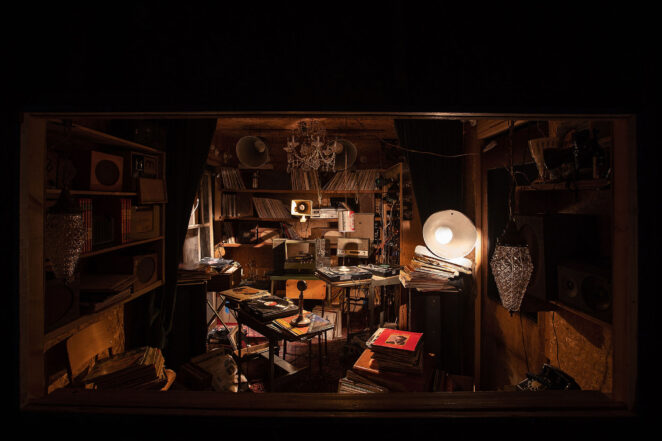
Janet Cardiff and George Bures Miller (Canada). Opera for a Small Room, 2005. Mixed media with sound, record players, records and synchronized lighting. 20 minute loop
More Left for You
Tracing back Kaunas Biennial history, it’s clear that as our world is rapidly evolving so is the art and our artistic ideas regarding it. What once was an exhibition involving textile art, today is the greatest most anticipated event amongst Baltic art festivals. In this article, I’ve spoken about two places, one contemporary and one interwar modern, where visitors will be able to see the 13th Kaunas Biennial exhibition. I’ve briefly mentioned a few artworks that analyze humanity’s long-lasting questions about life, death, adaptation, and more.
Interwar modern space is important not only as a visual stimulant but for artworks as well. In “Tadas Ivanauskas Zoological Museum” visitors are greeted with a somewhat alternate reality where exhibits are hybrids – man-made and nature-made creations merging to show us a new truth about species. It’s in our minds whether we’ll believe it or not. In the same place amongst a meticulous pile of long-dead bodies, we can ponder what is life, death, where do we come from where will we go after death. Installation and accompanying sound-based research give us a more philosophical background while appreciating beauty in animals, insects, and different kinds of once-living nature that’s been preserved amongst us.
I could not forget the main venue for this Kaunas Biennial. It’s in recently opened contemporary “House of Basketball”. There visitors will be able to dive into visual and sound narratives surrounding our existence. While there is a lot of artworks reminding us of Biennial’s past – textile media-based exhibitions, these days Kaunas Biennial is much more.
It not only involves international collaborations between talented artists but shows us some unexpected formats such as mise en scène of a man’s life.
Although I spoke about places and expositions that resonated with me, I encourage every reader to see all venues for themselves. I didn’t discuss the intriguing collaboration between Lithuanian artist Artūras Raila and Belarusian students all well as international stars such as Canadian Shary Boyle. Seeing all that this year’s Biennial can offer will take time, so stay in Kaunas at least for a few days and explore its history and captivating art.
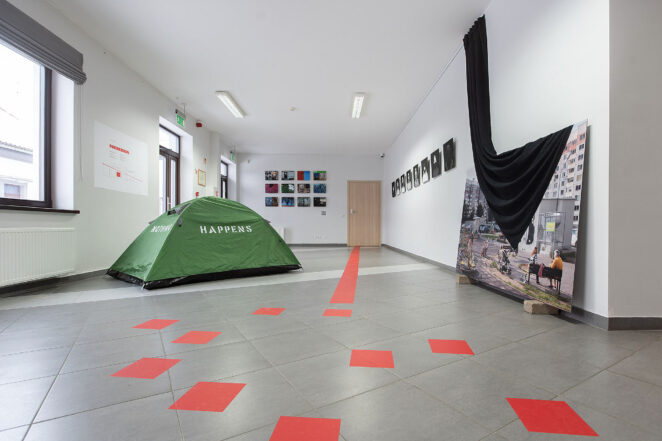
Artūras Raila (Lithuania) special project with the Belarusian students. INSOMNIA
Photos: Kaunas Biennial

